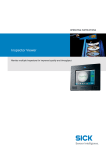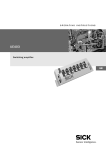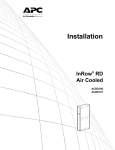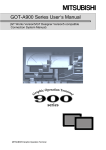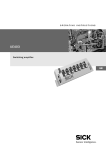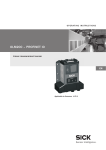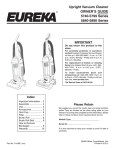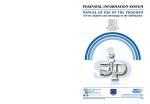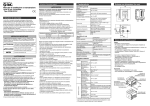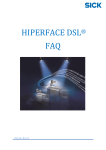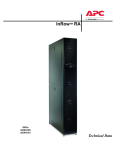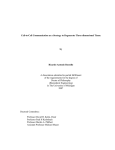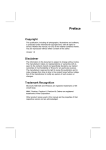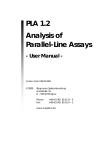Download PGT-09-S Programming Tool and Analyzer
Transcript
MANUAL PGT-09-S Programming Tool and Analyzer E Manual PGT-09-S Table of Contents 1 Scope .................................................................................................................. 4 1.1 2 Requirements ..................................................................................................... 5 2.1 Network (LAN / WAN) ............................................................................................. 5 2.2 PC (client host)........................................................................................................ 7 2.2.1 Microsoft Windows® with Internet Explorer 7 ................................................... 7 2.2.2 Microsoft Windows® with Internet Explorer 6 ...................................................10 2.3 3 4 Accessory ..............................................................................................................16 Installation ........................................................................................................ 17 3.1 Power Supply .........................................................................................................17 3.2 Ethernet connection ...............................................................................................17 3.3 DSL connection ......................................................................................................18 3.4 TRIGGER connection.............................................................................................19 3.5 Setup .....................................................................................................................20 3.5.1 Master Mode Setup .........................................................................................20 3.5.2 Slave Mode Setup ...........................................................................................21 3.5.3 Analyzer Mode Setup ......................................................................................22 Getting Started ................................................................................................. 23 4.1 Starting the PGT-09-S ............................................................................................23 4.2 User-interface Basics .............................................................................................24 4.3 Configuration - Login ..............................................................................................25 4.3.1 Language Choice ............................................................................................25 4.3.2 Operating Mode ..............................................................................................26 4.3.3 Access Profile .................................................................................................26 4.4 2 Related Documents ................................................................................................. 4 Page Layout ...........................................................................................................28 SICK STEGMANN GmbH Subject to change without notice Manual PGT-09-S® 4.5 5 6 7 Master Mode ..................................................................................................... 33 5.1 Status .....................................................................................................................33 5.2 Tabs .......................................................................................................................35 5.2.1 Master Registers .............................................................................................35 5.2.2 Remote Registers ...........................................................................................36 5.2.3 Encoder Resources .........................................................................................38 Slave Mode ....................................................................................................... 40 6.1 Status .....................................................................................................................41 6.2 Tabs .......................................................................................................................41 6.2.1 Encoder Resources .........................................................................................41 6.2.2 Encoder Emulation ..........................................................................................41 6.2.3 Faulty DSL H-FRAME .....................................................................................43 Analyzer Mode .................................................................................................. 49 7.1 Status .....................................................................................................................49 7.2 Tabs .......................................................................................................................49 7.2.1 Configuration ...................................................................................................49 7.2.2 Data Acquisition ..............................................................................................54 7.3 Analyzer Data Formats...........................................................................................59 7.3.1 H-Frame Mode ................................................................................................59 7.3.2 Position Mode .................................................................................................60 7.3.3 Message Mode................................................................................................60 7.3.4 Events .............................................................................................................61 7.4 8 Sequencer..............................................................................................................30 Protocol Signal Bits ................................................................................................62 Revision history ............................................................................................... 63 8013604/ WT29 SICK STEGMANN GmbH Subject to change without notice 3 Manual PGT-09-S 1 Scope This manual provides the user with basic guidelines for properly using the PGT-09-S tool (SICK order no 1 037 530). The PGT-09-S is a versatile engineering and diagnostic tool for use with motor-feedback systems based on the communication interface HIPERFACE DSL® by SICK. 1.1 Related Documents Technical data and order information on the PGT-09-S can be found in the data sheet (SICK order no 8 013 606). For further, general information on the protocol HIPERFACE DSL® please refer to the “User Manual HIPERFACE DSL®” (SICK order no 8 013 607). 4 SICK STEGMANN GmbH Subject to change without notice Manual PGT-09-S® 2 Requirements 2.1 Network (LAN / WAN) The PGT-09-S must be connected to an Ethernet network (TCP / IP based) and is integrated as a node (server host) into a LAN or WAN. DHCP, DNS, HTTP, … Transmission Control Protocol (TCP) The support of a DHCP and DNS server is mandatory for automatically configuring the IP address of the PGT-09-S device and for registering its host name into the specific namespace of the network. This way a user can easily access the device by its name. Please contact the appropriate network administrator to check the availability of DHCP and DNS services in your network. Please also make sure that network security restrictions (e.g. firewalls) do not inhibit access to the PGT-09-S device. 8013604/ WT29 SICK STEGMANN GmbH Subject to change without notice 5 Manual PGT-09-S Optionally a UDP connection (port 8001, limited broadcast protocol) is also supported for finding an active PGT-09-S device connected to the network. This mechanism reliably works even if the IP address of the device is unknown or the device is not reachable by an ordinary TCP connection, e.g. if it is configured for a different subnet. This scanner utility application is supplied on the CD shipped with the PGT-09-S device. 6 SICK STEGMANN GmbH Subject to change without notice Manual PGT-09-S® 2.2 PC (client host) The PGT-09-S offers access through a web browser application running on a client host connected to the same network (using a common subnet mask). In general two important settings in the employed web browser are required: Change the web browser configuration so that “pop-up windows” from the PGT-09-S device are accepted and shown. Configure the temporary files handling so that cache is not used in order to allow the web browser to always ask for the most recent page version. Specific instructions for these settings are given for example systems. 2.2.1 Microsoft Windows® with Internet Explorer 7 For allowing “pop-up windows” please follow these steps: Open Internet Explorer 7. Click on the “Tools” menu entry. Click on “Pop-up Blocker”. Click on “Pop-up Blocker Settings”. The “Pop-up Blocker Settings” window will open. 8013604/ WT29 SICK STEGMANN GmbH Subject to change without notice 7 Manual PGT-09-S Add the IP address or host name of the PGT-09-S device to the list of allowed sites. To configure correct cache handling follow these steps: 8 Open Internet Explorer 7. Click on the “Tools” menu entry. Click on the “Internet Options” entry. The “Internet Options” window will open. SICK STEGMANN GmbH Subject to change without notice Manual PGT-09-S® Under “Browsing history” click “Settings”. The “Temporary Internet Files and History Settings” window will open. 8013604/ WT29 SICK STEGMANN GmbH Subject to change without notice 9 Manual PGT-09-S Check the button “Every time I visit the webpage” for “Check for newer versions of stored pages” 2.2.2 Microsoft Windows® with Internet Explorer 6 For allowing “pop-up windows” please follow these steps: 10 Open Internet Explorer 6. Click on the “Tools” menu entry. Click on the “Internet Options” entry. The “Internet Options” window will open. SICK STEGMANN GmbH Subject to change without notice Manual PGT-09-S® Click on the “Privacy” tab. 8013604/ WT29 SICK STEGMANN GmbH Subject to change without notice 11 Manual PGT-09-S 12 Click “Settings” under “Pop-up Blocker”. The “Pop-up Blocker Settings” window will open. SICK STEGMANN GmbH Subject to change without notice Manual PGT-09-S® Add the IP address or host name of the PGT-09-S device to the list of allowed sites. To configure correct cache handling follow these steps: Open Internet Explorer 6. Click on the “Tools” menu entry. Click on the “Internet Options” entry. The “Internet Options” window will open. 8013604/ WT29 SICK STEGMANN GmbH Subject to change without notice 13 Manual PGT-09-S 14 Under “Temporary Internet files” click “Settings”. A “Settings” window will open. SICK STEGMANN GmbH Subject to change without notice Manual PGT-09-S® Check the button “Every time to the page” for “Check for newer versions of stored pages” Click “OK” in this window. Click “OK” in the “Internet Options” window. 8013604/ WT29 SICK STEGMANN GmbH Subject to change without notice 15 Manual PGT-09-S 2.3 Accessory The required accessories to be used along with the PGT-09-S are: The power supply (12V DC) that is part of the delivery. A cabling set suitable for the HIPERFACE DSL® link (M12 connector) A suitable Ethernet cable (RJ45 connector) The PGT-09-S datasheet should be referred for finding more details. 16 SICK STEGMANN GmbH Subject to change without notice Manual PGT-09-S® 3 Installation 3.1 Power Supply The PGT-09-S can be alternatively powered by: an external power-supply (12V DC) as the one that is part of the delivery. the HIPERFACE DSL® connection The power-supply connector (jack type) is placed on the panel opposite to the HIPERFACE DSL® connectors. Please check that the required polarity is matching with the following specification. Supply voltage DC 12V ±10% - + The PGT-09-S can supply a connected HIPERFACE DSL® encoder (DSL OUT) with power. It is not possible to supply a second PGT-09-S connected to the DSL IN or OUT ports. WARNING Please note that the supply voltage of the PGT-09-S matches with the supply voltage range of a connected HIPERFACE DSL® encoder (usually 7-12 VDC). Supplying a PGT-09-S with a voltage higher than the rated encoder supply will lead to irreversible damage to a connected encoder. The two specific pins of the HIPERFACE DSL® connectors (M12, pin 4 and 3, PWR+ and PWRrespectively) must be used to feed or draw power. Connector DSL IN 1 PIN 1 Signal DSL+ 2 DSL- 3 4 PWRPWR+ 1 DSL+ 2 DSL- 3 4 PWRPWR+ 2 4 3 DSL OUT 2 1 3 4 Description Data HIPERFACE DSL Data HIPERFACE DSL Ground connection 12 VDC supply voltage Data HIPERFACE DSL Data HIPERFACE DSL Ground connection 12 VDC supply voltage 3.2 Ethernet connection The PGT-09-S has an Ethernet port (RJ45) able to operate as 10BaseT or 100BaseTX mode, Full-Duplex; the operating mode is automatically selected at start-up. 8013604/ WT29 SICK STEGMANN GmbH Subject to change without notice 17 Manual PGT-09-S The PGT-09-S must be connected to the Ethernet network through a port of an “Ethernet Switch” (a “Hub” device could also be used but is not recommended, as the communication performance might get worse). 3.3 DSL connection The PGT-09-S provides user with two HIPERFACE DSL® connectors (M12), designated OUT and IN; in spite of the distinction and different connectors (male/female), their pins are equivalents (internal parallel connection). These two separated connectors are fully exploited in the ANALYZER mode (see chapter 7), when the PGT-09-S is interconnected between a HIPERFACE DSL® Encoder and a servo drive implementing the HIPERFACE DSL® Encoder Interface (“DSL Master”). Note that these connectors allow you to connect both 2-wire and 4-wire HIPERFACE DSL® lines. For a 2-wire connection, the pins PWR+ and DSL+, respectively PWR- and DSL- have to be short-cut externally to the PGT-09-S. PGT-09-S PWR+ DSL+ DSL- DSL encoder with 2-wire interface PWR- 18 SICK STEGMANN GmbH Subject to change without notice Manual PGT-09-S® 3.4 TRIGGER connection The PGT-09-S has a BNC connector suitable for supporting a trigger or “sync” function, depending on the operating mode of the tool. The PGT-09-S datasheet must be referred for finding full details on the electrical specification. 1 2 The interface can be used to feed a “sync” signal to the tool operating in Master mode (see chapter 5). Using this interface, the HIPERFACE DSL® encoder position acquisition is synchronized with the external “sync” signal. For further details on the acquisition synchronization, please refer to the HIPERFACE DSL® User Manual (SICK order no 8013607). The TRIGGER interface can also be used to feed a trigger signal to the tool when operating in Analyzer mode (see chapter 7). In this case data logging is triggered by an external event. 8013604/ WT29 SICK STEGMANN GmbH Subject to change without notice 19 Manual PGT-09-S 3.5 Setup The PGT-09-S is a dedicated tool for a HIPERFACE DSL® link. It is designed to function for different purposes (see chapters 5, 6, 7). Depending on the configuration the HIPERFACE DSL® connection has to be set up accordingly. Refer to the diagrams below showing the individual setup requirements. 3.5.1 Master Mode Setup The following figure shows the scenario where the HIPERFACE DSL® encoder is supplied from the PGT-09-S. Ethernet switch Ethernet connections SYNC signal (optional) Hiperface DSL® encoder Hiperface DSL® link (2 or 4 wires) Supply (12V DC) PGT-09-S Power supply In the figure below the power supply for the encoder is used to also supply the PGT-09-S through the DSL connector IN. 20 SICK STEGMANN GmbH Subject to change without notice Manual PGT-09-S® Ethernet switch Ethernet connections SYNC signal (optional) Hiperface DSL® encoder Hiperface DSL® link (2 or 4 wires) PGT-09-S Supply (12V DC) Power supply 3.5.2 Slave Mode Setup Below the setup for the SLAVE mode is shown. The PGT-09-S is powered through the DSL IN connection. Ethernet switch Ethernet connections Servo Drive with Hiperface DSL® interface Hiperface DSL® link (2 or 4 wires) Supply (12V DC) PGT-09-S Power supply 8013604/ WT29 SICK STEGMANN GmbH Subject to change without notice 21 Manual PGT-09-S 3.5.3 Analyzer Mode Setup Below the setup for the ANALYZER mode is shown. The PGT-09-S is powered through the DSL IN connection. Servo Motor with integrated Hiperface DSL® Encoder Ethernet switch Ethernet connections Servo Drive with Hiperface DSL® interface Hiperface DSL® links (2 or 4 wires) Supply (12V DC) PGT-09-S Power supply 22 SICK STEGMANN GmbH Subject to change without notice Manual PGT-09-S® 4 Getting Started 4.1 Starting the PGT-09-S The PGT-09-S is a versatile tool providing the user with different operating modes as listed belowe: MASTER mode as explained in chapter 5 SLAVE mode as explained in chapter 6 ANALYZER mode as explained in chapter 7 The MASTER mode provides the user with specific functionalities for interfacing a HIPERFACE DSL® Encoder. The tool is operating as a servo drive HIPERFACE DSL® Encoder Interface (DSL Master) and the user is able to access all DSL Master functions (e.g.: position and status readout) and the HIPERFACE DSL® Encoder resources for monitoring and programming purpose. The SLAVE mode makes the tool a HIPERFACE DSL® Encoder emulator. The ANALYZER mode provides the user with specific functionalities for a deep investigation on the HIPERFACE DSL® link for focusing on data transmission issues. For the PGT-09-S are two different operating modes available. HDEB-mode, offers a windows based platform. The software can be downloaded free of charge on our homepage www.sick.com/software/PGT-09-S, in the Tutorial “HIPERFACE DSL encoder browser (HDEB)” the handling and the basics functions of the software are described. Target group for this operating mode are marketing and sales people. The tutorial as well as other information is available on the website: www.sick.com/hiperfacedsl Webserver-mode, offers access to all registers which are implemented in the specific motor feedback system. The functions and the handling is described ongoing in this document. Target group for this operating mode are technicians and software engineers. The Webserver mode can be selected from the PGT-09-S home-page, which is shown as default in the web browser application window after accessing the PGT-09-S host. Access is made by entering the device DNS name http://DSL-AN-xxxxxxxxx/ as indicated on the product label. 8013604/ WT29 SICK STEGMANN GmbH Subject to change without notice 23 Manual PGT-09-S Please note that it might be necessary to use a “fully specified” host name including the network domain like http://DSL-AN-xxxxxxxxx.yourdomain/ Please consult your network administrator if you experience problems in this regard. Alternatively, if the access by host name is not possible, the IP address of the PGT-09-S device can also be entered in the web browser address bar. The IP address can be found by using the scanning utility supplied on the CD shipped with the PGT-09-S device. 4.2 User-interface Basics Before proceeding, it is worth focusing on the user-interface basics and the way to interact with the active objects located on the displayed pages by using a mouse and keyboard: 24 “Clicking” or “Double-Clicking” actions refer to the standard use of the left-button of the mouse. “Pushing a Button” also refers to the use of the left-button of the mouse to activate a function associated with a push-button. “Cursor Keys” are accepted to browse either a list-view or a text-field to be edited. Standard edit-specific-keys are accepted. The “Enter-Key” is used both to start an edit session and to confirm the edited value. The “Escape-Key” is used to abort an editing session. SICK STEGMANN GmbH Subject to change without notice Manual PGT-09-S® 4.3 Configuration - Login As soon as the Web browser successfully accesses the PGT-09-S the home page is shown as displayed in the following screenshot. This startup page allows the user to select the language and the operating mode of the tool. 4.3.1 Language Choice By clicking on the flag icon placed near the top-right corner, a scrolling list is shown in order to select an implemented language through the choice of national flags. A double-click on the selected flag determines the corresponding language setting. 8013604/ WT29 SICK STEGMANN GmbH Subject to change without notice 25 Manual PGT-09-S 4.3.2 Operating Mode The operating mode of the PGT-09-S determines the basic function of the tool in a DSL connection (Master, Slave, or Analyzer). The operating mode is selectable through the push-button placed near the bottom-left corner. The active mode is shown as the button caption: By pushing this button the list of operating modes is shown. Select and click a mode to make it active. The selected mode is kept after power-down. 4.3.3 Access Profile The access profile of the PGT-09-S determines which functions the user has access to. The access profile is selectable through the push-button placed near the bottom-right corner. The active profile is shown as the button caption: By pushing this button the list of operating modes is shown. Select and click a mode to make it active. For any access profile except “User”, a password is required. The password is entered after pushing the START button. If so required, a window will request the password for the indicated access profile: The passwords for the access profiles are listed in the following table: 26 SICK STEGMANN GmbH Subject to change without notice Manual PGT-09-S® Access Profile User Power-User Password (no password needed) 2222 After password entry, the start screen of the requested operating mode is shown. The following screenshot shows the MASTER mode page as an example. 8013604/ WT29 SICK STEGMANN GmbH Subject to change without notice 27 Manual PGT-09-S 4.4 Page Layout The page layout is common to all operating modes. The layout contains three areas: Header Main Windows Status Bar The header integrates different information (logos, timestamp, tool name, mode) along with some push buttons, as shown below: Please note that the name of the tool (DSL-AN-111111111) and the current selected mode (MASTER) are located inside the central bar as a big title. Two buttons are located on the right-hand side: for showing a quick guide. for saving the current workspace and returning to the splash page. The main window is reserved to the actual workspace. It is restored on startup if previously saved. At the top of the workspace are horizontally aligned tabs. Each is related to a specific function and can be pushed to activate (and show) or deactivate (and hide) the function itself. For most functions the workspace is filled by the following objects: 28 A list-view at the top, to be used as an “item pool” (e.g.: registers or resources). A list-view (“sequencer”) for acting on the items selected from the previous list-view . SICK STEGMANN GmbH Subject to change without notice Manual PGT-09-S® A control panel with some push buttons to be used for activating specific functions. The referred list-views can be browsed by using cursor keys. A row selection is done by clicking on a row. It will appear highlighted (upper and lower borders orange-colored, text characters red-colored). This is demonstrated in the screenshot below: In order to execute a Read, Write or Clear access to any register or resource, it must first be inserted into the sequencer relevant to the access execution according to the following procedure: 1. Select a register from the item pool 2. Hit the key (case insensitive) corresponding to the permitted access (“R”,”W”,”C”). Please refer to the chapter Sequencer (4.5) to learn how to handle items after insertion into the list-view . The “Status Bar” is reserved to status information, as shown hereafter: As a common feature to all operating modes the “Status Bar” is mainly used for displaying dynamic events along with the identity logged on to the device. On the right-hand side an arrow icon shows the HIPERFACE DSL® link status: DSL link up DSL link up, but Parameter Channel down DSL link, maybe, down DSL link down Two text-fields are located in the middle of the “Status Bar”. The one on the left serves for displaying a message relevant to the running action whereas the one on the right serves for 8013604/ WT29 SICK STEGMANN GmbH Subject to change without notice 29 Manual PGT-09-S monitoring the message strings exchanged between the user interface (the client host) and the PGT-09-S (the server host). 4.5 Sequencer The “Sequencer” can be defined as a list of operations (item accesses) to be executed, sequentially or randomly. It is associated with a list-view of items to be accessed for reading, writing or clearing. As an example some list-views of items to be accessed are shown hereafter: MASTER Mode, Master Register access: MASTER Mode, Remote Registers access: MASTER Mode, Encoder Resources access: 30 SICK STEGMANN GmbH Subject to change without notice Manual PGT-09-S® A set of specific commands associated with keyboard commands (case insensitive) are available to handle the execution list content. These commands only ever apply to a selected row: “X” Execute specific access operation on the selected item. “D” Disable execution of selected item. “E” Re-enable execution of selected item. “P” Set a breakpoint at the selected item ( flagged by “Home” Define the first item of an execution sequence ( flagged by ). “End” Define the last item of an execution sequence ( flagged by ). “Del” Remove selected item from execution list. ). These keyboard commands are displayed when pushing the header “Quick Guide” button. Note that “X” and “Del” are only executed if the “Sequencer” is stopped (please refer to the following control panel description). The execution list can also be handled by using push buttons of the control panel placed beside the execution list-view: Please note that the execution sequence is defined as long as the first and the last item are defined, see below. First and last items can be redefined even while the execution is running. The mode of the execution sequence can be set by using the selector at the top of the control panel: allows executing continuous access in a loop from first to last defined item. The push button starts the execution loop. The push button breaks the execution loop. will cause a single loop of access once the push button is hit. 8013604/ WT29 SICK STEGMANN GmbH Subject to change without notice 31 Manual PGT-09-S The push button is automatically shown after a “P” command (set breakpoint). Use it to continue the execution loop after the breakpoint. The control panel includes further push buttons for saving, loading, and clearing the execution list. Please note that these operations are independent from the automatic save/load operations associated with the exit push button on the header. Please note that the save operation uses one storage slot so that the last stored execution list will be overwritten. Two more push buttons are placed on the control panel not strictly relevant to the execution list. They are used to either reinitialize the complete HIPERFACE DSL® link or the protocol channel handling messages exchange. 32 SICK STEGMANN GmbH Subject to change without notice Manual PGT-09-S® 5 Master Mode The Master mode provides the user with specific functionalities for interfacing a HIPERFACE DSL® Encoder. The PGT-09-S is operating as a HIPERFACE DSL® Encoder Interface (“DSL Master”) and the user is enabled to access the DSL Master registers (local and remote registers, e.g.: position and status readout) as well as all HIPERFACE DSL® Encoder resources for monitoring and parameterization purposes. 5.1 Status The main status information is relevant to the HIPERFACE DSL® link. A quick report is provided by the arrow icon shown at the right-hand side of the “Status Bar”. Please refer to the description of the status bar for further details (see chapter 4.4). A status word (“Online DSL Master Status”) is also shown as a hexadecimal value in the workspace (on the “DSL Status” push button). By pushing the “DSL Status” button a detailed information is shown as a list of bits. A set bit is depicted as a small red square: 8013604/ WT29 SICK STEGMANN GmbH Subject to change without notice 33 Manual PGT-09-S The meaning of each status bit is explained in detail in the HIPERFACE DSL® Manual. For a quick overview the following common values are explained: 34 A value of “1003” or “5003” notifies the user of a positive HIPERFACE DSL® link status. The value “5003” also notifies that a warning or error bit is set in one of the eight encoder status bytes (ENC_ST0..7, found under “Remote Registers”). Please note that the warning bit “Protocol Reset” is always set after establishing a HIPERFACE DSL® link. Values like “1B00”, “3B00”, or “5B00” indicate that the HIPERFACE DSL® link is down. SICK STEGMANN GmbH Subject to change without notice Manual PGT-09-S® 5.2 Tabs At the top of the workspace are horizontally aligned tabs. Each is related to a specific function and can be pushed to activate or deactivate the function itself. 5.2.1 Master Registers This function allows the user to access (Read / Write / Clear) all local registers of the HIPERFACE DSL® Encoder Interface (“DSL Master”). For further details on the available registers and their function please refer to the HIPERFACE DSL® Manual. The related workspace layout is shown below: The list-view at the top includes all available local registers. Each row is related to a register and includes the following specific information: Register Address Register Name Register Extended Name Register Data on Reset Permitted Access Type ( R-ead; W-rite; C-lear ) The appended list-view is relevant to the register access execution. Each row includes the following specific information: 8013604/ WT29 SICK STEGMANN GmbH Subject to change without notice 35 Manual PGT-09-S Sequencer Index Access Type Register Address Register Name Register Data (hexadecimal value) Register Data (binary value) 5.2.2 Remote Registers This function allows the user to access (Read / Write / Clear) interface registers of the HIPERFACE DSL® Encoder (“DSL Slave”), mirrored as remote registers of the HIPERFACE DSL® Encoder Interface (“DSL Master”). For further details on the available registers and their function please refer to the HIPERFACE DSL® Manual. The related workspace layout is shown below: The list-view at the top includes all available remote registers. Each row is related to a register and is showing the following specific information: 36 Register Address Register Name Register Extended Name Register Data on Reset Permitted Access Type ( R-ead; W-rite; C-lear ) SICK STEGMANN GmbH Subject to change without notice Manual PGT-09-S® The appended list-view is relevant to the register access execution. Each row is including the following specific information: Sequencer Index Access Type Register Address Register Name Register Data (hexadecimal value) Register Data (binary value) 8013604/ WT29 SICK STEGMANN GmbH Subject to change without notice 37 Manual PGT-09-S 5.2.3 Encoder Resources This function allows the user to access (Read / Write) all parameter resources of the HIPERFACE DSL® Encoder. For further details on the available resources and their function please refer to the specific HIPERFACE DSL® Encoder datasheet along with further protocol details specified by the HIPERFACE DSL® Manual. The related workspace layout is shown below: The list-view at the top includes all available resources of all HIPERFACE DSL® Encoders. Please note that individual encoders might not implement all resources. This is indicated in the product datasheet. Each row is related to a specific “Group of Resources” (a node of the resource tree). the following specific information is listed: 38 Node Name Resource Name Resource Identifier (RID) Resource Size (Bytes) Permitted Access Type ( R-ead; W-rite ) Access Level (the minimum required) Resource Timeout (ms) Resource Address SICK STEGMANN GmbH Subject to change without notice Manual PGT-09-S® Resource Type The appended list-view is relevant to the resource access execution. Each row is including the following specific information: Sequencer Index Access Type Resource Name Resource Data Offset Hexadecimal Data Value Binary Data Value Resource Access Error-Code The control panel on this page also contains an additional field showing the currently set access level for resource access. Please set the desired access level by using the resource “Set Access Level” in the “Administration Node”. 8013604/ WT29 SICK STEGMANN GmbH Subject to change without notice 39 Manual PGT-09-S 6 Slave Mode The Slave mode provides the user with specific functionalities for emulating a HIPERFACE DSL® Encoder. The PGT-09-S in Slave mode implements full HIPERFACE DSL® link support (position, status, messages) and a reduced set of resources. This mode is useful for testing and validating the implementation of the HIPERFACE DSL® Encoder Interface (“DSL Master”). Along with the possibility to generate functional errors (EGx), a special functionality allows user even to force bit-errors in the basic DSL bit-frame, the so called, “Horizontal Frame” (H-FRAME). Note that “Power-User” access profile is required to make it available (see chapter 4.3.3). 40 SICK STEGMANN GmbH Subject to change without notice Manual PGT-09-S® 6.1 Status The main status information is relevant to the HIPERFACE DSL® link. A quick report is provided by the arrow icon shown at the right-hand side of the “Status Bar”. Please refer to the description of the Status Tab for further details (chapter 4.4). 6.2 Tabs At the top of the workspace tabs are displayed. Each is related to a specific function and can be pushed to activate or deactivate the function itself. 6.2.1 Encoder Resources This function allows the user to examine the list of resources implemented in the emulated HIPERFACE DSL® Encoder. For further details on the available resources and their function please refer to the HIPERFACE DSL® Manual. The related workspace layout is shown below: 6.2.2 Encoder Emulation The emulated HIPERFACE DSL® Encoder includes a “position generator” running at constant speed. Besides, specific error codes can be generated on demand. 8013604/ WT29 SICK STEGMANN GmbH Subject to change without notice 41 Manual PGT-09-S This function allows the user to set up the parameters of the emulated HIPERFACE DSL® Manual Encoder, specifically: Initial position value Position increment on every HIPERFACE DSL® frame Error codes The screenshot below shows the related page and the objects to be used for setting the parameters referred above. Two parameters are relevant to the “position generator” and they are set with two text fields under the header “POSITION”. By clicking on the field an edit session can start. The “Enter” key closes the edit session and makes the value active. The error codes are grouped according to the HIPERFACE DSL® Encoder datasheet. Each error bit of each group (excluding those reserved) can be set or reset by clicking on the associated box as shown below: 42 SICK STEGMANN GmbH Subject to change without notice Manual PGT-09-S® Above of the error bit checkboxes a field functioning as a push button is placed to show the corresponding error byte value. To make an error code active please push this error byte push button. 6.2.3 Faulty DSL H-FRAME The “Faulty DSL H-FRAME” is a special functionality, useful to generate specific error conditions in the basic DSL bit-frame (H-FRAME), in order to test the DSL system under faulty conditions. Note that “Power-User” access profile is required (see chapter 4.3.3). Different error types can be configured to affect the selected bits (sequential) of the frame, at the raw data-stream level (functional errors) or at the encoded data-stream level (communication errors simulation). The error condition can even be triggered by combining internal and external events (internal protocol states and external signal, fed thru the BNC connector). Here is the basic steps to make it working: Raw / Encoded bits selection Fault configuration Trigger configuration Configured fault setting Fault status monitoring The specific information on the fault status is a direct feedback on the “error generator” status; the effects of the generated error must be captured elsewhere (e.g.: by using a further tool in the Master Mode or Analyzer Mode). 8013604/ WT29 SICK STEGMANN GmbH Subject to change without notice 43 Manual PGT-09-S The Raw / Encoded bits selection is achieved by un-checking / checking the specific checkbox in the panel placed on the left-top side where the corresponding total bits in the H-FRAME are also shown. On the mid-right-top side the basic specification of the H-FRAME format (Raw / Encoded) is shown as well. Please note the bit enumeration: the 1st-transmitted bit is referred as bit47 (Raw) or bit59 (Encoded); hence the bit0 is the one transmitted last. The following figure shows some more bit details: Besides the selection above defining the fault target, a complete fault setup is also requiring the fault specification, defined based on the selectors available in the specific panel, the following one: Starting from the left-end-side, the first drop-down selector defines the “fault type” affecting the range of the sequential bits (up to the whole frame), specified by means of both the next two specific selectors (“From…To”). The total affected bits are also shown beside. The selectable self-explained fault types are shown hereafter; the topmost selection (NONE) can be simply used to make the fault configuration inactive. A further specification is required; i.e., the quantity of the affected H-FRAME’s; that can be specified based on the selector placed on the right-end side. Again, the topmost selection (NONE) can be used to make the fault configuration inactive. 44 SICK STEGMANN GmbH Subject to change without notice Manual PGT-09-S® Ultimately an optional specification refers to the event (state / signal) triggering the configured fault action. The trigger, if enabled, can be based on two different and independent types of event; that is, a specific internal protocol state and / or an external signal, fed thru the BNC connector. The trigger setup can be done by using the following selectors placed in a panel on the rightend-side: The external trigger is disabled / enabled by means of the specific 2-way selector . The internal trigger is instead enabled when one internal protocol state is selected; that is, one different than the topmost selection (OFF) disabling the specific trigger use. Referring to the protocol states, a list with a short description follows: 8013604/ WT29 SP_RESET DSL slave interface reset (protocol stack restart) SP_SHOW_ID Encoder ID sent to DSL master SP_START Waiting a vertical sync to enter SP_TX0...TX7 loop SP_TX0 The 1st byte of the vertical channel (Summary) is generated SP_TX1…5 Refer to the absolute position (MS-Byte…LS-Byte) slicing SP_TX6…7 Refer to the CRC (15:0) of the vertical channel SICK STEGMANN GmbH Subject to change without notice 45 Manual PGT-09-S Besides the diagram showing the DSL slave states transition is hereafter enclosed too Please, refer to the specific DSL protocol description for the most complete description of the internal protocol states handling. 46 SICK STEGMANN GmbH Subject to change without notice Manual PGT-09-S® Once the fault parameters are selected, they have to be transferred to the fault generator; so, a specific push-button shown on the left-bottom has to be used for making the shown setup active. The button above is shown on condition that both the fault type and the faulty frames are selected different than “NONE”; additionally the fault generation must be in the “OFF” state (inactive). Such a condition can be verified looking at the text field placed above the button. Please, note that anytime the setup is changed the current active configuration is reset and the inactive status (OFF) is entered. On pushing the aforementioned button, the current setup is uploaded and then the fault generator is activated; please, monitor the status transitions shown in the specific status field above the button. Here is shown the fault status change sequence: 1> > 2> > 3> 4> Please, note the 3rd state is held until the fault occurs. So, if any trigger event is configured, the 3rd state is hold while the event is not occurring and the setup is not changed; whereas, the 3rd state could even be not visible on un-triggered fault generation An useful feature is additionally available to the user; that is, the possibility to save and reload any fault setup. The saved setup are shown into a drop-down list to be quickly selected. Two specific push-buttons are located on the right-bottom; above them, the saved setup list and the current selected setup are shown. 8013604/ WT29 SICK STEGMANN GmbH Subject to change without notice 47 Manual PGT-09-S On the save operation, the text-field above the buttons is suitable for editing a setup name (an ASCII identifier, 16 characters long) that is accepted an used to identify the setup on the save confirmation. The user can confirm to proceed processing the shown identifier by using the ENTER key; the ESC key has instead to be used to abandon. On the load operation, the text-field above the buttons is not editable, showing instead the identifier selected from the list and picked up by double-clicking the left-button of the mouse. As for the save operation, the ENTER key or the ESC have to used to proceed or abandon the load operation. Please, note that the double-click over the list is processed to choose an identifier as the current one, both for save and load operations. Note besides that the top-most selection (arrow sequence) is suitable for closing the list upon a single mouse click. 48 SICK STEGMANN GmbH Subject to change without notice Manual PGT-09-S® 7 Analyzer Mode The Analyzer mode provides the user with data-logger functionalities in order to monitor link behavior. Data-logging is based on user set conditions, and it is possible to trigger with an external signal (see TRIGGER connector, chapter 3.4). The Analyzer mode allows a deep investigation of link issues on protocol level. In order to use this mode effectively please consult the HIPERFACE DSL® Manual. 7.1 Status The main status information is relevant to the HIPERFACE DSL® link. A quick report is provided by the arrow icon shown at the right-hand side of the “Status Bar”. Please refer to the description of the Status Tab for further details (chapter 4.4). 7.2 Tabs At the top of the workspace are horizontally aligned tabs. Each is related to a specific function and can be pushed to activate or deactivate the function itself. 7.2.1 Configuration This function allows the user to configure data-logging by setting: 8013604/ WT29 SICK STEGMANN GmbH Subject to change without notice 49 Manual PGT-09-S the acquisition mode the acquisition trigger the events log filter (“Watch Filter Mask”) For further details on the configuration above, please, refer to the Analyzer Data Formats (chapter 6) along with further protocol details specified by the HIPERFACE DSL® Manual. The related workspace layout is shown below: Please note that upon entering this page the currently active configuration is shown. Any change must be confirmed by the push button. As long as a changed configuration is not confirmed, a tab switch is not possible. After updating a configuration the push button goes hidden to notify of a successful change. Relevant to the configuration setup more push buttons are available: Read out the active configuration setup (undoing unconfirmed changes) Save the shown configuration setup (single storage entry only) Restore previously saved configuration setup 50 SICK STEGMANN GmbH Subject to change without notice Manual PGT-09-S® Acquisition Mode The acquisition mode can be set by using the selector placed on the top left-hand side: The selectable modes are the following: The “H-Frame” mode allows logging raw protocol data exchanged on the HIPERFACE DSL® link. The “Position” mode allows logging position acquisition data as available in the HIPERFACE DSL® Encoder Interface (DSL Master). The “Message” mode is specifically related to Short and Long Message exchange (HIPERFACE DSL® Encoder resource access). The “Event” mode is suitable to log specific events: Watch signal changes (based on the Watch Filter, see configuration above) Trigger event (if configured) Timestamp counter overflow Trigger Setup The trigger for logging data can be defined based on four parameters. The trigger depends on the result of a logical comparison defined through the following settings: Source Mask Mode Threshold The trigger “Source” field refers to the byte of the Watch Filter Mask to be used for triggering. Please note that each byte is referred by the associated watch filter name as displayed on screen: 8013604/ WT29 SICK STEGMANN GmbH Subject to change without notice 51 Manual PGT-09-S The “Mask” field (1 byte) is suitable to mask bits of the selected trigger source. Click on it to start an edit session. The “Enter-Key” is required to confirm the edited value. The “Mode” field defines the logical operation to be applied on the selected and masked trigger source. A drop-down box allows to choose the desired operation. Please note that the first defines the “no trigger” condition (trigger disabled). selection The symbol definition is common to some software development languages: “Equal” / “Not Equal” ” Less Than” / “Less Than or Equal” “Greater Than” / “Greater Than or Equal” The “Threshold” field (1 byte) is suitable to define the value to which the masked trigger source is compared with. Click on it to start an edit session. The “Enter-Key” is required to confirm the edited value. Watch Filter Mask The “Watch Filter Mask” (64-bit mask) is used to filter which events are actually logged when triggered. The text field shows the active pattern based on the bit patterns set by the user in the check boxes below it: This field can be used as a push-button. On clicking the shown pattern is made active. The filter bit patterns can be defined bit-by-bit by using the associated checkboxes: by clicking the user can toggle the selected bit. On top of the checkboxes corresponding text fields functioning as push buttons are placed and show the corresponding byte value. To make their values active they have to be clicked. 52 SICK STEGMANN GmbH Subject to change without notice Manual PGT-09-S® The meaning of the event bits is explained in chapter 6. 8013604/ WT29 SICK STEGMANN GmbH Subject to change without notice 53 Manual PGT-09-S 7.2.2 Data Acquisition In this tab the user can control and monitor the data-logging process. The related workspace layout is shown below: Three main sections can be identified within the workspace: Header Main Window Bottom Section The Header is constituted of two bars (an upper-bar and a lower-bar) related to acquisition setup and acquisition status. On the left-hand side of the upper-bar the active acquisition mode and the trigger configuration status are shown: On the right-hand side of the upper-bar a push button to start and stop the acquisition along with a field showing the acquisition status are placed: as shown upon start to stop a running acquisition. as shown upon stop to start a new acquisition. 54 SICK STEGMANN GmbH Subject to change without notice Manual PGT-09-S® shown on triggered acquisition completion. On the lower-bar of the Header fields related to acquisition timestamps are placed, as shown below: The timestamps refer to the following events: acquisition start acquisition stop first logged record last logged record The list-view in the main window shows the logged records whose specific format is depending on the acquisition mode (see chapter 7.3): Please note that the contents of the listed record fields can be copied and pasted into a text file or spreadsheet by clicking and dragging with a mouse and using appropriate Copy/Paste actions as provided by the web browser. H-Frame mode record format The record fields are defined as follows: Record index Event code (if any) Timestamp of the record Master data packet (Encoder Interface -> Encoder) Primary slave data packet (Encoder -> Encoder Interface) Secondary slave data packet (Encoder -> Encoder Interface) Data link layer encoding special characters 8013604/ WT29 SICK STEGMANN GmbH Subject to change without notice 55 Manual PGT-09-S Data link layer encoding errors Watch signal changes related to an event Position mode record format The record fields are defined as follows: Record index Event code (if any) Timestamp of the record Summary bit byte Vertical position (absolute position) Vertical position CRC Accumulated position Watch signal changes related to an event Message mode record format: The record fields are defined as follows: 56 Record index Event code (if any) Timestamp of the record Message sender (Master or Slave) with Read / Write attribute Message address (2-nibble for ShortMsg; 3-nibble for LongMsg Address offset (LongMsg only, if any) Message data (if any) Message CRC Watch signal changes related to an event SICK STEGMANN GmbH Subject to change without notice Manual PGT-09-S® Event mode record format: The record fields are defined as follows: Record index Event code Timestamp of the event Watch signal changes related to an event Additional notes: Event codes are identified as follows: o W identifies changes in watch signals o <<T>> identifies a trigger reference o TOVF! identifies a timestamp overflow (if any) the timestamp can have different resolution depending on the acquisition mode: o full (23bit,13.56 ns) all modes but Message mode o reduced (14bit, 694 ns) Message mode In the bottom section a bar is placed showing both the number of acquired records and those listed. Also, a push button is available to enable or disable storage of records in the PGT-09-S device. Note that the data acquisition is buffered and the buffer is dimensioned to store up to 2048 records. Trigger The acquisition trigger allows to log data only under specific conditions. Setting the trigger also allows the user to synchronize acquisition to an external signal (refer to the TRIGGER connection, chapter 3.4). Please note that to configure the trigger based on an external signal the trigger source must include the “AUX” bit of the POSITION events byte. Please note that the trigger is disabled on startup. If the trigger is disabled, all data on the HIPERFACE DSL® link is logged when starting an acquisition. 8013604/ WT29 SICK STEGMANN GmbH Subject to change without notice 57 Manual PGT-09-S The trigger setup is handled by the Configuration function (see chapter 7.2.1). If the configured trigger condition occurs a started acquisition is stopped. The acquisition buffer is handled so that the record associated with the trigger is stored in the middle of the buffer. This way the logged records are equally split into half before and after the trigger. Data logging The data logging is a process collecting specific formatted records into the acquisition buffer (dimensioned to store up to 2048 records) on condition that: The acquisition mode is selected The acquisition process is activated (start button was pressed) The trigger condition if configured has occurred The data amount is available The data logging can be differentiated by selecting the acquisition mode. It can be refined by setting a proper configuration. Events filtering The so called “events” (refer to the specific types specified above) are always logged in the acquisition buffer regardless of the active acquisition mode. Therefore it is recommended to set up specific event filtering through the watch filter setup (refer to the Configuration function, chapter 7.2.1) to avoid that too many event records fill the acquisition buffer. 58 SICK STEGMANN GmbH Subject to change without notice Manual PGT-09-S® 7.3 Analyzer Data Formats Each Analyzer operating mode (see chapter 7.2.1) uses a different 128 bit data format to store logged entries. This chapter defines these data formats to allow identification of logged data. Please note that by default unused bits in a log entry are not cleared. Therefore they can contain arbitrary data. 7.3.1 H-Frame Mode The 128 bits of a log entry in H-Frame mode are specified as follows: Bit position 127 (MSB) 126 … 104 103 … 96 Width 1 23 8 Value range 0 00 00 00 … 7F FF FFh 00 ... FFh 95 … 56 40 55 … 48 8 00 00 00 00 00 … FF FF FF FF FFh 00 … FFh 47 … 40 47 46 45 44 43 42 41 40 39 … 32 39 38 37 36 35 34 33 32 31 … 0 8 00 … FFh 8 00 … FFh 8013604/ WT29 32 Meaning Escape bit Time stamp (full resolution, 13.56 ns) Master data (Encoder Interface -> Encoder) Primary slave data (Encoder -> Encoder Interface) Secondary slave data (Encoder -> Encoder Interface) Special character flag Master data Primary slave byte 1 Primary slave byte 2 Primary slave byte 3 Primary slave byte 4 Primary slave byte 5 Secondary slave Reserved for future use Data link encoding error flag Master data Primary slave byte 1 Primary slave byte 2 Primary slave byte 3 Primary slave byte 4 Primary slave byte 5 Secondary slave Reserved for future use Not used (arbitrary values) SICK STEGMANN GmbH Subject to change without notice 59 Manual PGT-09-S 7.3.2 Position Mode In Position mode the time stamp is related to the position sampling edge of the “Vertical Position” (absolute position). The 128 bits of a log entry in Position mode are specified as follows: Bit position 127 (MSB) 126 … 104 103 … 96 95 … 56 Width 1 23 8 40 55 … 40 39 … 0 16 40 Value range 0 00 00 00 … 7F FF FFh 00 ... FFh 00 00 00 00 00 … FF FF FF FF FFh 00 00 … FF FFh 00 00 00 00 00 … FF FF FF FF FFh Meaning Escape bit Time stamp (full resolution, 13.56 ns) Encoder error summary Vertical Position (absolute position, primary channel) Vertical Position CRC Accumulated Position (incremental position) 7.3.3 Message Mode Please note that possibly unused fields in Message mode (e.g. data bytes or offset values) are unknown and are to be discarded. The 128 bits of a log entry in Message mode are specified as follows: Bit position 127 (MSB) 126 … 113 Width 1 14 Value range 0 00 00 … 3F FFh 112 1 111 … 96 16 0 1 00 00 … FF FFh 95 … 80 79 … 64 16 16 00 00 … FF FFh 00 00 … FF FFh 63 … 0 64 00 00 00 00 00 00 00 00 … FF FF FF FF FF FF FF FFh Meaning Escape bit Time stamp (reduced resolution, 6.94 µs) Messages source: Slave Messages source: Master Message address (remote register address or resource identifier) Message CRC Message offset value (only for Long Message) Data field of message (0, 2, 4, or 8 bytes) Please note that in case of Short Message transfer, the Address field will contain both the address byte and the possible data byte. The lower 80 bits of the log entry are to be discarded. 60 SICK STEGMANN GmbH Subject to change without notice Manual PGT-09-S® 7.3.4 Events In all modes, events are stored as log entries. They are encoded as follows: Time stamp counter overflow After a time stamp counter overflow (every 100 ms), an overflow event is stored as a log entry. Its format is as follows: Bit position 127 (MSB) 126 … 104 103… 96 95 … 0 Width 1 23 8 96 Value range 1 00 00 00h 03h Meaning Event indicator Time stamp reset value Escape sequence: time stamp overflow Not used Trigger When the configured trigger conditions are met, a trigger event is stored as a log entry. Its format is as follows: Bit position 127 (MSB) 126 … 104 103… 96 95 … 0 Width 1 23 8 96 Value range 1 00 00 00 … 7F FF FFh 02h Meaning Event indicator Time stamp (full resolution, 13.56 ns) Escape sequence: trigger Not used Watch signals When the configured watch signals change, a watch signal event is stored as a log entry. Its format is as follows: Bit position 127 (MSB) 126 … 104 103… 96 95 … 32 Width 1 23 8 64 31 … 0 32 8013604/ WT29 Value range 1 00 00 00 … 7F FF FFh 01h 00 00 00 00 00 00 00 00 … FF FF FF FF FF FF FF FFh Meaning Event indicator Time stamp (full resolution, 13.56 ns) Escape sequence: watch signal Watched signals (see chapter 7.4) Not used SICK STEGMANN GmbH Subject to change without notice 61 Manual PGT-09-S 7.4 Protocol Signal Bits For in-depth HIPERFACE DSL® link investigations, a set of protocol signals can be monitored by setting appropriate Watch Filters (see chapter 7.2.1). A protocol signal event is recorded if the signal bit changes. Some bits are grouped together into multi-bit words. For them an event is recorded if the record condition is met as indicated in the following table. Bit position 63 … 56 (MSB) 55 … 52 51 … 48 47 46 … 40 39 38 37 36 35 34 33 32 31 30 29 28 … 24 23 22 21 20 … 16 15 14 … 12 11 … 8 7…4 3…0 62 Signal summary(7:0) Meaning Encoder error summary (see HIPERFACE DSL® Manual) mp_state(3:0) Encoder Interface (DSL Master) protocol state machine sp_state(3:0) Encoder (DSL Slave) protocol state machine Reserved for future use err8b(6:0) Master, Slave, and Slave 2 data link encoding errors (see chapter 7.3.1) Reserved for future use lockd Encoder clock recovery state first Drive sync signal indicator msync Vertical frame start indicator aux External trigger input state pos_not_valid Position accumulator error acc_crc_error Accumulated position CRC error vrt_error Vertical frame CRC error Reserved for future use ms_smsg_bad Short message error (Encoder Interface -> Encoder) ms_lmsg_bad Long message error (Encoder Interface -> Encoder) m_par(4:0) Message data (Encoder Interface -> Encoder) Reserved for future use sm_smsg_bad Short message error (Encoder -> Encoder Interface) sm_lmsg_bad Long message error (Encoder -> Encoder Interface) s_par(4:0) Message data (Encoder -> Encoder Interface) Reserved for future use ms_rssi(2:0) Signal strength indicator (Encoder Interface -> Encoder) sm_rssi(3:0) Signal strength indicator (Encoder -> Encoder Interface) Reserved for future use qm(3:0) Quality monitor (see HIPERFACE DSL® Manual) SICK STEGMANN GmbH Subject to change without notice Record Condition Treated as single bits watch value watch value Treated as single bits Single bit Single bit Single bit Single bit Single bit Single bit Single bit Single bit Single bit watch value Single bit Single bit watch value < watch value < watch value watch value Manual PGT-09-S® 8 Revision history Revision 0.10 0.20 0.30 0.40 Change Initial draft First issue Revision Corrected pinning, Watch filter explanation Date 2009-09-15 2010-01-19 2010-01-25 2010-02-19 Author M. Rossello M. Rossello S. Stein S. Stein 0.50 New Slave-Mode feature: Faulty DSL HFrame; Encoder Emulation revision: EG0 & EG1 setting; Ch. 4.1: Addition of HDEB-mode Ch.3.5.2: Corrected figure (power supply not optional) Ch.3.5.3: Corrected figure (power supply not optional) 2010-09-23 M. Rossello 2012-12-12 C.Bitsch 0.60 8013604/ WT29 SICK STEGMANN GmbH Subject to change without notice 63 8013604/2013-01-15 ∙ 7MSUP (2010-02) ∙ A4 4c int39 Australia Phone+61 3 9457 0600 1800 334 802 – tollfree E-Mail [email protected] Belgium/Luxembourg Phone +32 (0)2 466 55 66 E-Mail [email protected] Brasil Phone+55 11 3215-4900 E-Mail [email protected] Canada Phone+1(952) 941-6780 +1(800) 325-7425 - tollfree E-Mail [email protected] Ceská Republika Phone+420 2 57 91 18 50 E-Mail [email protected] China Phone +86 4000 121 000 E-Mail [email protected] Phone +852-2153 6300 E-Mail [email protected] Danmark Phone+45 45 82 64 00 E-Mail [email protected] Deutschland Phone+49 211 5301-301 E-Mail [email protected] España Phone+34 93 480 31 00 E-Mail [email protected] France Phone+33 1 64 62 35 00 E-Mail [email protected] Great Britain Phone+44 (0)1727 831121 E-Mail [email protected] India Phone+91–22–4033 8333 E-Mail [email protected] Israel Phone+972-4-6881000 E-Mail [email protected] Italia Phone+39 02 27 43 41 E-Mail [email protected] Japan Phone+81 (0)3 3358 1341 E-Mail [email protected] Magyarország Phone+36 1 371 2680 E-Mail [email protected] Nederlands Phone+31 (0)30 229 25 44 E-Mail [email protected] SICK AG | Waldkirch | Germany | www.sick.com Norge Phone+47 67 81 50 00 E-Mail [email protected] Österreich Phone+43 (0)22 36 62 28 8-0 E-Mail [email protected] Polska Phone+48 22 837 40 50 E-Mail [email protected] România Phone+40 356 171 120 E-Mail [email protected] Russia Phone+7-495-775-05-30 E-Mail [email protected] Schweiz Phone+41 41 619 29 39 E-Mail [email protected] Singapore Phone+65 6744 3732 E-Mail [email protected] Slovenija Phone+386 (0)1-47 69 990 E-Mail [email protected] South Africa Phone+27 11 472 3733 E-Mail [email protected] South Korea Phone+82 2 786 6321/4 E-Mail [email protected] Suomi Phone+358-9-25 15 800 E-Mail [email protected] Sverige Phone+46 10 110 10 00 E-Mail [email protected] Taiwan Phone+886 2 2375-6288 E-Mail [email protected] Türkiye Phone+90 (216) 528 50 00 E-Mail [email protected] United Arab Emirates Phone+971 (0) 4 88 65 878 E-Mail [email protected] USA/México Phone+1(952) 941-6780 1 (800) 325-7425 – tollfree E-Mail [email protected] More representatives and agencies at www.sick.com
































































